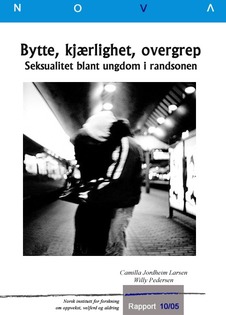Bytte, kjærlighet, overgrep
Report

Åpne
Permanent lenke
https://hdl.handle.net/20.500.12199/3215Utgivelsesdato
2005Metadata
Vis full innførselSamlinger
- NIBR notat [1018]
Sammendrag
The background for this report is recent research on adolescents who sell sex. The studies have brought to light a long range of experiences that involve the exchange of sex for other goods, but that do not easily fit into fixed categories. Sometimes terms like "prostitution" or "survival sex" seem appropriate, other times they do not. In addition we wanted to study relations and situations in which sex seemed to play a problematic role. The report is based on 60 in-depth interviews with adolescents and young adults. The selected samples were not based on sex sale experiences, but on characteristics that have been indicated - by quantitative studies - to give increased risk of sex sale. Accounts of experiences we traditionally would label prostitution were scarce among the adolescents we interviewed. However, there seemed to be a relatively high occurrence of less clear cut experiences of sex exchange among those who had high levels of alcohol and drug use. For girls we identified a pattern of much older boyfriends who supplied them with drugs. For boys in their mid teens we saw a pattern of adult men in their home environment whose home served as a place to hang out. The boys were often given cigarettes, alcohol or money, and their visits were often filled with exciting activities. For some, this might be an arena where sex is exchanged for money or other goods. Adolescents lacking experience with heavy drugs did not tell of such experiences. They did, however, tell of sexual harassment in public areas and sexual interest from adults in their home surroundings. A surprising finding was that girls seemed more aware of the sexual content of such interest than boys. This might have implications for their competence to respond adequately. Another finding - in tune with quantitative studies - was that they found it easier to reject sexual interest from strangers than from acquaintances or people they had a close relationship with, such as teachers, parents of friends or boyfriends. In some instances they also seemed to have difficulties with labeling an experience rape if the rapist was their own boyfriend. Sexual violence seemed to be experienced more frequently by adolescents who used drugs. The internet is an arena which offers specific sorts of risks, especially when it comes to sexual abuse. The adolescents were aware of the risks involved, and seemed competent to handle them in most cases. Still, they sometimes admitted to breaking their own rules, in search of excitement. Exchange relations between unfamiliar adults and adolescents without what we normally label ö‚«risk factorsö‚», initiated on the internet, also occur. However - as is the case offline - adolescents find it easier to reject strangers than adults they already know.The report is written in Norwegian. Begrepet ungdomsprostitusjon leder ofte tankene til situasjoner hvor en mindreårig selger seksuelle tjenester til en kunde som betaler. Rapporten belyser handlinger og relasjoner som ikke nødvendigvis lar seg beskrive slik, men hvor seksualitet likevel inngår som byttemiddel. Jenter i begynnelsen av tenårene kan være kjærester med eldre gutter eller voksne menn som tilbyr rusmidler. Unge gutter kan gå på besøk til spandable menn i nabolaget. Vi belyser dessuten hvordan mobiltelefon og internett spiller en ny rolle og også påvirker forutsetningene for å inngå ulike seksuelle bytteforhold.Hovedkonklusjonen i rapporten er at vanskelige livssituasjoner ofte bringer med seg smertefulle erfaringer også på det seksuelle området. Misbruk av rusmidler er et nøkkeltema som dukker opp i livet til en rekke av de mest utsatte ungdommene. Vi ser på hvordan slike seksuelle erfaringer arter seg, hvem som er utsatt og hvorfor de er det.Erfaringene som diskuteres ligger i grenselandet mellom seksuelle overgrep, prostitusjon, såkalt "survival sex" og vanlig seksuell aktivitet. I rapporten skisseres de sentrale begrepene samt teoritradisjonene hvor de har blitt utviklet. Datamaterialet består av kvalitative intervjuer med seksti ungdommer. Utvalget ble selektert ut fra variabler som tidligere er vist å gi risiko for salg av seksuelle tjenester. Ungdommene er mer belastet enn gjennomsnittet, samtidig som mange er det vi vil gjenkjenne som "vanlig ungdom".